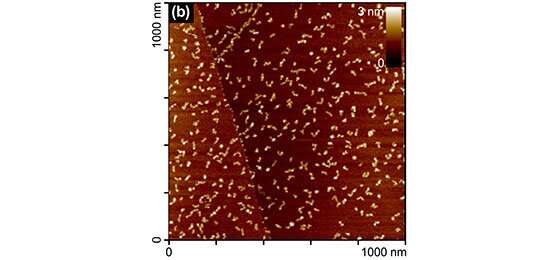Graphene nanoflakes: A new tool for precision medicine

Chemists funded by the SNSF have created a new compound for flexible drug delivery that specifically targets prostate cancer cells. Incorporating four different molecules, the compound prevents tumor cells from multiplying, can be detected by medical imaging and has staying power in the bloodstream.
Usually, a drug is administered indiscriminately and most of it does not reach the diseased tissues. The goal of precision medicine is to increase the efficacy of therapeutic substances by delivering them only to the proper target. This requires a customized drug delivery system. A team funded by the Swiss National Science Foundation has developed a new approach based on graphene nanoflakes, which are extremely small pieces of graphene (a regular atomic-thin arrangement of carbon atoms). They added different types of molecules to single nanoflakes to transform them into a customized system for drug delivery. The results are published Chemical Science.
Like Lego bricks
Jason Holland's team at the University of Zurich succeeded in attaching four kinds of molecules to single graphene nanoflakes to imbue them with specific capacities: transporting an anticancer drug, delivering it only to certain cancerous cells, making it visible by medical imaging and prolonging its stay in the bloodstream. In a second step, the team tested each functionality to verify that the new compound works as expected.
"Our work demonstrates how to use the graphene nanoflakes as a universal delivery mechanism," explains Ph.D. student Jennifer Lamb, first author of the publication. "They can be used as a scaffold onto which one can add customized components, a bit like Lego bricks. This is possible because of their chemical structure: the edge of the flake is made of carboxyl groups—CO2H—where additional molecules can be attached."
New compounds against cancer
First, collaborators at University College London produced the graphene nanoflakes from carbon nanotubes. Then the Zurich team attached four molecules to single flakes. The first molecule, ispinesib, is a drug currently in development that halts mitosis (cell division) and thereby prevents the growth of tumors. The second molecule is a peptide that binds to prostate-specific membrane antigens (PSMAs), which are overexpressed in prostate cancer cells. The third molecule (DFO) is a cage-like molecule that efficiently catches radioactive gallium, an isotope routinely used in PET (positron-emission tomography) scanning. This standard medical imaging technique helps first in diagnosing prostate cancer and then in ensuring that the compound is delivered to the diseased tissues. Finally, the researchers caused the compound to interact with albumin in the blood; this prevents its rapid filtering by the kidney and increases the time it stays in circulation.
In a second step, the team tested the new compound. Studies performed on cultures of prostate cancer cells showed that their division and growth were indeed halted. In live mice, PET imaging showed that the compound accumulates in diseased tissues, but not for long enough, says Lamb: "Because of their small size, the constructs are still excreted too rapidly for a sustained therapeutic effect. But our experiments showed ways to influence drug excretion by changing the structure of the graphene." The team is now experimenting with other combinations involving antibodies instead of small peptides: the antibodies bind better to cancer cells, and their larger size should cause them to remain longer in the bloodstream.
"Our research is fundamental, and much more work will be needed to develop a new drug," says project leader Jason Holland. "But our results do open promising new avenues for oncological precision treatment as well as for theranostics. This combination of therapeutic agents and diagnostic tools can help ensure that the treatment is appropriate for the disease, and for the patient."
More information: Jennifer Lamb et al. Multi-functionalised graphene nanoflakes as tumour-targeting theranostic drug-delivery vehicles, Chemical Science (2019). DOI: 10.1039/C9SC03736E
Journal information: Chemical Science
Provided by Swiss National Science Foundation


















